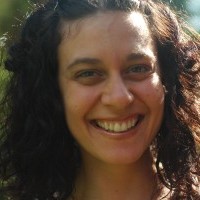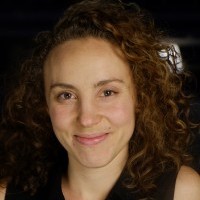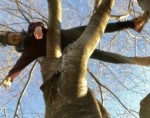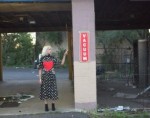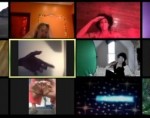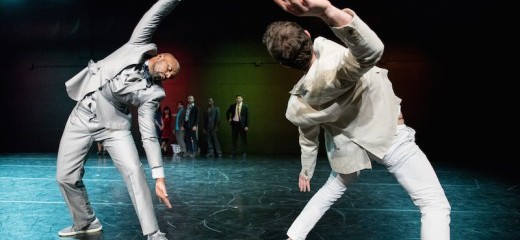
Archiving Occupation, Identity and Resistance
by Nicole Bindler and Hadar Ahuvia
tD writer Nicole Bindler and guest writer Hadar Ahuvia discuss two works–Archive and Badke–presented in the New York Live Arts, Live Ideas Festival, curated by Tommy Kriegsmann and Adham Hafez. This year’s series features work from the Middle East and North Africa. Archive by Israeli Arkadi Zaides features video of Israeli soldiers and settlers taken by Palestinians, coordinated by the human rights organization, B'Tselem. Zaides performs in front of the footage and embodies the actions of the cameras’ subjects. Badke, a collaboration between Belgian dance companies, KVS, les ballets C de la B and the Palestinian organization A.M. Qattan Foundation, features ten Palestinian dancers from various disciplines including hip hop, ballet, contemporary, and circus arts. All of the dancers perform Palestinian folk dance, Dabke. Nicole and Hadar also report on a post-show talk facilitated by André Lepecki, and a pre-show talk facilitated by Alisa Solomon.
Nicole on Badke
I hear stomping and vocalizing in the dark, and see residual mist from a fog machine. The performers of Badke stand in a line, drum the floor with their feet in unison as the lights slowly rise. They don formal wear, dresses, and jackets.
Samaa Wakeem dances casually, as if alone to music by Naser Al-Fares that wisps out of her hot pink headphones. Suddenly the music blasts out of the theater speakers and the dancers coalesce into a unison flock that canter and loop with arms outstretched.
Throughout the dance they continually diverge into simultaneous happenings then merge into unison Dabke.
Salma Ataya in a red dress kicks, punches, and swings at Fadi Zmorrod who looks at her with icy blue eyes. He alternately throws her on his shoulder and mock-strangles her. Ayman Safiah performs intricate, balletic jumps while Maali Maali, and brothers Mohammed and Samer Samahnah perform flips. Others meander and chat casually.
The ten line up holding hands to perform fast, knee crunching footwork, beaming bright smiles. Those at the end of the line swing invisible keffiyehs in their hands, scarves that are often twirled in traditional Dabke lines. In this moment I only see a circling of the wrist and a ghost scarf.
They begin to sweat. The men take off their jackets. Someone gets some water from a cooler upstage. Another takes a break in a chair as the mayhem and spectacle continues onstage.
The lights and sound cut out as they are prone to do in Palestine due to poor infrastructure and Israeli military occupation. The performers gather upstage in the dark, singing and drumming the water cooler.
When the electricity comes back on the dancers resume their wild, ecstatic partying. Relationships build and disappear, groups separate and join together in a smooth blending and shifting of dance styles... is this virtuosic, danced code switching?
They are intoxicated. The music is loud, relentless, and manic. M. Samahnah performs a belly dance, S. Samahnah plays limbo under his legs, and Hiba Harharsh grabs her own breasts as if discovering them for the first time. Everyone jiggles their butts and humps the floor like inch worms. Ameer Sabra remains upstage in a chair, head in hands, embodying the inevitable alienation one feels at some point at every party.
Sabra begins to yell as if coughing up an invading spirit. He writhes, shakes, and grimaces. Four sitting women and three men piled on top of each other like fish at the market watch Sabra’s torment. Then they drag him away.
It is now silent except for the chilling thud of ten prone dancers hitting their foreheads against the floor, hands behind their heads as if they have been pulled over and ordered to the ground at a checkpoint by the Israeli Defense Forces.
The music becomes muffled and they move as if underwater, walking backwards with their hands up. My breath slows, and my attention softens as I am beckoned into a mesmerized state. I’m torn awake when once again everything cuts to black.
Hadar on Archive
Zaides begins the piece standing downstage beside his technical equipment. A projection screen is set up behind him. He explains that he lived in Tel Aviv for fifteen years, just twenty miles away from the West Bank, and that all the people who will appear in the videos he obtained from B'Tselem are Israelis.
Zaides clicks a remote to bring up the first images of sky, landscape, and a beautiful hill in the Hebron region of the West Bank. Each piece of footage is identified by a companion slide with the Palestinian videographer’s name, location, and date projected on the back wall of the theater.
Though we never see the faces of the videographers, we’re aware of their presence from the sound of ambient conversation in Arabic or sudden jolts or changes in camera angle.
A group of settlers appears running up a street. Zaides jogs, imitating one of them, replicating his image in front of the screen. He mirrors a policeman standing arms akimbo. At first Zaides rehearses the gestures precisely. Later he manipulates them. A settler held between four soldiers forcefully resists arrest. Here Zaides captures an altercation between Israelis, in which the army is obligated to remove settlers from Palestinian land. Lying on his back, Zaides assumes the settler’s contractions, then clicks a small remote in his hand to replay the image and repeats the opening and closing of his own limbs.
Divorced from the original context, Zaides’s movements make the very consequential gestures of settlers, police, and the army seem mundane.
The footage is arranged in increasing brutality though it never reaches a peak of extreme violence. In a role reversal of an omnipresent image, Israeli teenagers assemble in gangs, and throw stones at the Palestinian videographers, and then destroy their groves and fields. A soldier fires tear gas at a Palestinian crowd out of view. We see lunges and raised arms. These images are abstracted into source material for Zaides’s dance. His identity as an Israeli man in relationship to the Palestinian videographers enables him to assume these roles, and ensures that the dance is never fully abstracted.
Zaides imitates a settler on the sideline of a frame we’ve already seen. A middle-aged man raises his arms towards an altercation between soldiers and settlers on Palestinian land, but otherwise stands still. Zaides, likewise stands at the edge of the projection screen, gazing to his left. By foregrounding these bystanders, Zaides implicates himself as a passive witness. I feel implicated too as an Israeli-American and as a silent audience member in the theater. In one of the final images Israeli children use mirrors to deflect light and blind the camera person. The mirrors point back to us, the viewers.
When Zaides transforms the nimbleness of Israeli children throwing stones into a coda of tour jetés, the violence becomes palatable and even seductive. On the other hand, Zaides’s performance is pronounced in its detachment from the violence. I ask myself if the disconnect between the violence onscreen and the dance is because of Zaides’s desire to distance himself from the gestures of occupation. Archive critiques this detachment as it performs it, and interrogates the viewer’s (my) desire for distance.
Zaides begins to mimic the sounds and speech of those on screen—cheers, guffaws—and the imitation begins to transcend the recreation of gesture. He repeats in several orientations the harrowing voice of a child yelling “kill him,” which reverberates through Zaides’s body and our own. He manipulates the sounds with a delay pedal to create a cacophony. This amplified sonic assault makes visceral what Zaides’s press release describes as “the potential for violence embedded in each individual.”
Nicole
At the pre-show talk Wakeem mentioned that it was difficult for her to watch the video in Archive because it demonstrated minor assaults compared to the extreme violence many Palestinians have faced at the hands of settlers and soldiers.
Hadar
I expected to see more violent footage. I wanted to see it, maybe because of a desire to expunge my guilt as an Israeli-American. I was concerned that some audience members would leave with a sense that these Israelis are just doing their job, as expressed by one woman in the audience. In the talk afterwards she described the soldiers as trapped in their situation, without agency. She interpreted Archive as a universal statement against violence, as opposed to a work by an Israeli positioning his body to implicate himself and his community.
On the other hand, I think Zaides’s choice to show less violent footage enables him to reach more people. I also think it’s incredibly powerful for him to turn around the image of throwing stones that has been used to villainize Palestinians by showing Israelis performing the same action. There are children no more than four years old in some of these videos, as well as gangs of teenagers with bats.
What did you think of The New York Times review of Badke by Gia Kourlas?
Nicole
I think that Kourlas is off when she says that Badke is “more Belgian than Palestinian” because it is “packaged and tour-ready.” The piece was created in collaboration with the Belgian choreographers who helped shape the work and the Palestinian dancers who devised the movement. Kourlas’s comment implies that Palestinians aren’t capable of making a polished work.
Furthermore, she says the work is inspired by Dabke and embellished by other forms, but those other techniques are more than an adornment. Badke is a hybrid work that arises directly out of the dancers’ own practice, training, and artistry which includes Dabke and other vocabularies they’ve studied in depth. The dancers hail from diverse backgrounds: one is a citizen of Israel living in Haifa, two are from a refugee camp in Nablus, some are from Ramallah and are of varying class backgrounds that have afforded them different kinds of training from parkour to ballet.
The curation of this festival by Kriegsmann and Hafez is groundbreaking. Have you ever seen anything like this?
Hadar
In my time in NYC I haven’t seen Israeli work presented as explicitly political and without Israeli government funding. Also, a large co-curatorial role was given to Adham Hafez, an Egyptian choreographer and scholar. In fact, in the fall the festival was first advertised with two Israeli headliners, but was then shifted to foreground Egyptian, Palestinian, Moroccan and other Arab artists who after all represent more of this region, and who are rarely presented by major presenters in the U.S. I’ve appreciated Tommy Kriegsmann’s growing sensitivity and thoughtfulness in his curatorial process.
Nicole
What were some highlights from the Lepecki talk after Archive?
Hadar
Lepecki drew the connection between Zaides’s work and the use of video in the US to capture images of state violence. Both in the US and West Bank these videos are used as evidence of everyday violent behavior by the police and military. They also betray a hope that if only this footage is seen the situation could be changed.
Lepecki specifically mentioned the police beating of Rodney King. During the playing of the video at the trial, it was manipulated by the defense to tell a different story. The defense stopped the playback almost frame by frame, to position each gesture of attack by the police as a defensive move. In contrast, Zaides maintains the integrity of the footage, playing it continuously.
Almost the entire audience stayed for the Lepecki talk. They were very invested in the work. What did you think of the vibe at the Badke show?
Nicole
I was struck by the passivity of the audience. The performers were dancing as if their lives depended on it and the audience consumed it silently. Wakeem mentioned at the talk before the performance that U.S. audiences were particularly prim as compared to those in the Arab world who clap, holler, and dance in their seats.
Hadar
Tell me more about the Solomon talk.
Nicole
Members of the Badke cast discussed their desire to make work that isn’t explicitly political, that it’s a privilege usually reserved only for people in a position of power. Farah Saleh said she’s allergic to Dabke for this reason—it’s a dance of resistance and she doesn’t want to be put in a box. Conversely, Zaides sounded committed to making political work because of his privileged position in their society.
I asked Zaides about his life pre and post Israeli state funding and he clarified that this Haaretz article is misleading: he was dropped by the Israeli Ministry of Foreign Affairs, but he actually still receives funding from the Israeli Ministry of Culture. The former was able to drop his funding easily based on political content, but the latter must adhere to technical criteria that Zaides’s work fulfills (try as they might to find loopholes to cease funding him—he’s had to hire a lawyer in order to maintain his status as a funded artist.)
One of the Palestinian speakers mentioned that Zaides’s not receiving Israeli state funding for this particular festival was an important condition for her performing alongside him, but that the cultural boycott of Israel should be considered on a case by case basis. She expressed support for Zaides’s using Israeli state funds to make political work in solidarity with Palestinians.
Archive, Arkadi Zaides, New York Live Arts, February 9-10; Badke, KVS, les ballets C de la B & A.M. Qattan Foundation, New York Live Arts, February 11-13; Open Spectrum Critical Community Dialogues: Artists in Dialogue – A Conversation Between the Artists of “Badke” and “Archive”, New York Live Arts, February 13, http://newyorklivearts.org/liveideas/.
By Nicole Bindler
March 10, 2016

